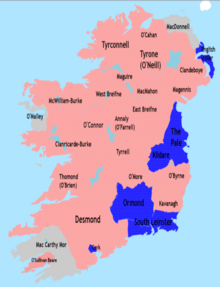
Back حرب التسع سنوات (أيرلندا) Arabic Brezel an nav bloaz (Iwerzhon) Breton Neunjähriger Krieg (Irland) German Naŭjara milito (Irlando) Esperanto Guerra de los Nueve Años (Irlanda) Spanish Yhdeksänvuotinen sota (Irlanti) Finnish Guerre de Neuf Ans en Irlande French Cogadh na Naoi mBliana (Éire) Irish Perang Sembilan Tahun (Irlandia) ID Guerra dei nove anni (Irlanda) Italian
This article needs additional citations for verification. (November 2021) |
| Nine Years' War | |||||||
|---|---|---|---|---|---|---|---|
| Part of the Tudor conquest of Ireland and the European wars of religion | |||||||
 Ireland in 1600 showing approximate Irish alliance control at its height (red), and English control (blue) | |||||||
| |||||||
| Belligerents | |||||||
|
|
| ||||||
| Commanders and leaders | |||||||
|
Irish lords: Hugh O'Neill Hugh Roe O'Donnell Hugh Maguire (DOW) Brian O'Rourke Fiach McHugh O'Byrne † Richard Tyrrell (POW) James Fitzthomas Cormac MacBaron O'Neill Donal Cam O'Sullivan Beare Spanish leaders: Martín de Padilla Juan del Águila Diego Brochero Alonso de Ocampo Pedro de Zubiaur full list... |
English leaders: William Fitzwilliam Henry Bagenal † John Norreys (DOW) William Russell Robert Devereux (Earl of Essex) Charles Blount (Lord Mountjoy) Thomas Norreys (DOW) George Carew Henry Docwra Arthur Chichester Irish loyalists: Niall Garve O'Donnell Donogh O'Brien Cahir O'Doherty Earl of Clanricard full list... | ||||||
| Strength | |||||||
|
~21,000, including: |
~5–6,000 (before 1598) ~18,000 (after 1598) | ||||||
| Casualties and losses | |||||||
| ~100,000 soldiers and Irish civilians (the vast majority died due to famine) | ~30,000 soldiers (though more died from disease than in battle) and hundreds of English colonists | ||||||
| Total dead: 130,000+ | |||||||
The Nine Years' War, sometimes called Tyrone's Rebellion,[1][2] took place in Ireland from 1593 to 1603. It was fought between an Irish confederation—led mainly by Hugh O'Neill of Tyrone and Hugh Roe O'Donnell of Tyrconnell—against English rule in Ireland, and was a response to the ongoing Tudor conquest of Ireland. The war began in Ulster and northern Connacht, but eventually engulfed the entire island. The Irish alliance won numerous victories against the English forces in Ireland, such as the Battle of Clontibret (1595) and the Battle of the Yellow Ford (1598), but the English won a pivotal victory against the alliance and their Spanish allies in the siege of Kinsale (1601–02). The war ended with the Treaty of Mellifont (1603). Many of the defeated northern lords left Ireland to seek support for a new uprising in the Flight of the Earls (1607), never to return. This marked the end of Gaelic Ireland and led to the Plantation of Ulster.
The war against O'Neill and his allies was the largest conflict fought by England in the Elizabethan era. At the height of the conflict (1600–1601) more than 18,000 soldiers were fighting in the English army in Ireland.[3] By contrast, the English army assisting the Dutch during the Eighty Years' War was never more than 12,000 strong at any one time.[3]
© MMXXIII Rich X Search. We shall prevail. All rights reserved. Rich X Search